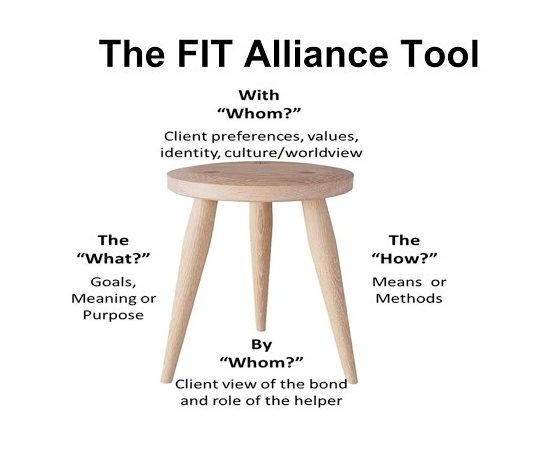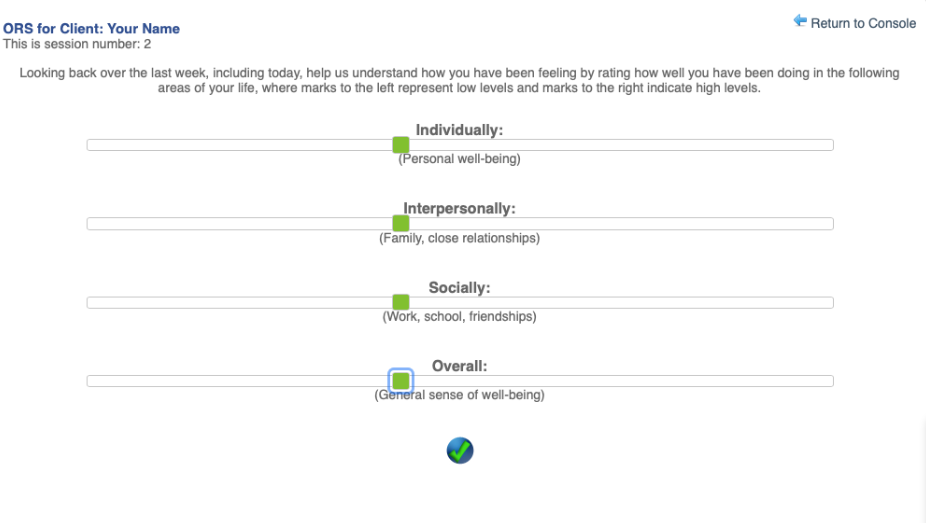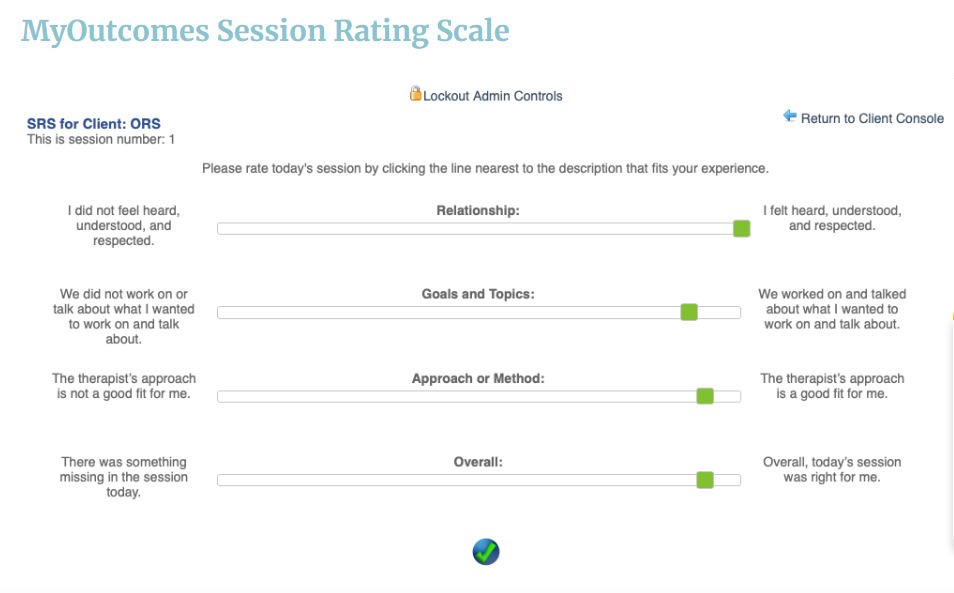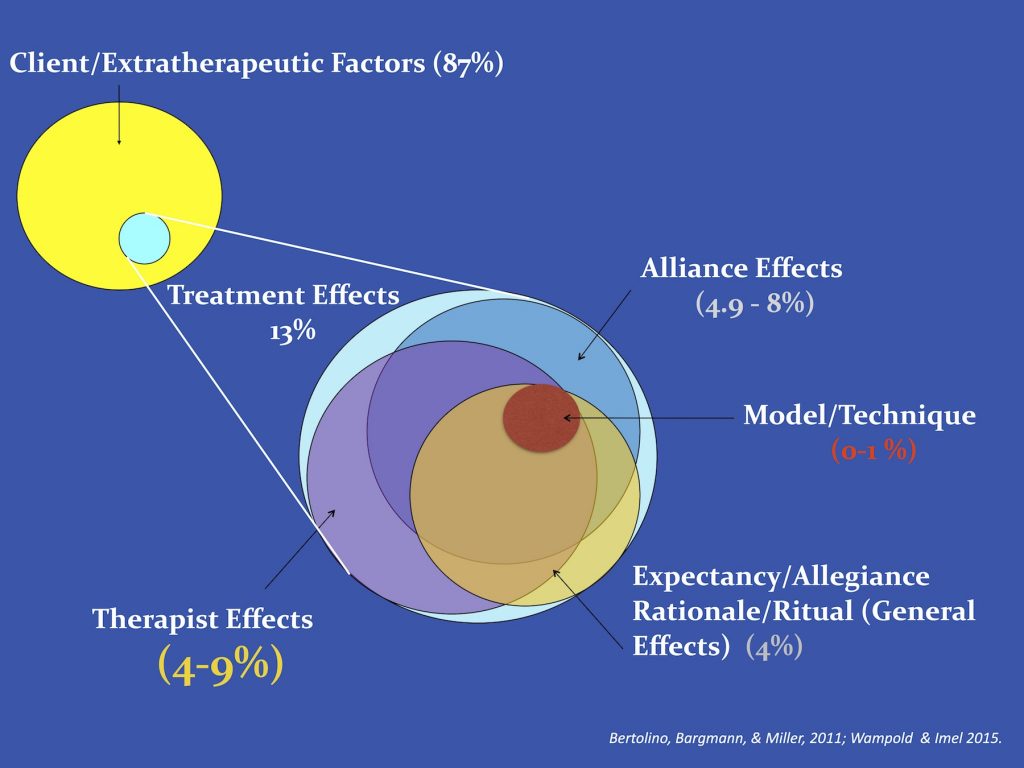Your Theory of Change

The FIT Alliance Stool: My most misused FIT TIP with Scott D. Miller
International Center for Clinical Excellence ICCE
Feedback Informed Treatment (FIT)
The most important thing you need to know about me is that I use I use an evidence-based practice called Feedback Informed Treatment (FIT). I work a little differently than other therapists. If our sessions are going to be helpful, you should see signs sooner rather than later, usually within the first 3 or 4 visits. If our work helps, you can continue as long as you like. If our work is not helpful, I’ll seek consultation at session 3 or 4 and consider a referral within no later than 8 to 10 sessions.
I believe you are inherently resourceful and are seeking the best life for yourself and those you care about. I’m here to help you tease out your theory of change. These are your own theories about your problems, how they developed and how to solve them.
I help you use your abilities and your preferred ideas of working to co-create a tailor-made treatment plan for you. Together we create your map to help you steadily work towards your goals. You are the most important contributor to the outcomes of therapy. Outcomes are the results that you wish to get from therapy.
My goal is to eventually become redundant to your life. I do this by helping you develop the skills to behave in line with your personal values and to effectively cope with life’s challenges. My greatest happiness is to hear you say “Thank you, you’ve helped a lot. I now know that I can do this on my own. I’ll call you if I need a tune-up session.”
The first few minutes of each session
Your ideas about your issues and what it may take to fix them are my main focus in each session. You’re hiring me as a thinking partner to co-create ideas, help you develop skills and grow your strengths so you can achieve what you believe will be helpful to you and your life.
I always ask you about your expectations and hopes about the changes you wish to make. At the start of each session I ask you to fill out a brief four question scale called the ORS, the Outcome Rating Scale, to provide feedback on your view of your progress in achieving your therapeutic goals.

Your resources
The resources you bring into the therapy room are the biggest influence on what happens in your life. Your individual qualities like your persistence, faith, hope; as well as a supportive friend, co-worker, family member, membership in a spiritual community or sports group all exist in your life external to therapy. These are what you go back to at the end of every therapy session. The interplay between your inner strengths, external supports and events outside of therapy, like a new job or successfully navigating a tricky situation, play a big role in bringing about change in therapy.
There are 336 hours in a fortnight. One 60 minute or 90 minute appointment every fortnight does little to change your inbuilt reactions. It takes daily practice of the skills I coach you in for you to make the required changes in your life. You are the engine of change in your own life.
Your theory of change
Your theory of change is the key to success, regardless of the methods used by me or any therapist. This is especially true if you’ve had unsuccessful therapy beforehand. Your feedback to me is critical to your improvement. My aim is to fit my ways of working to your ideas, expectations, strengths and goals. I’m the one that has to change and adapt to help you bring about the changes you want. This 5 minute video with Scott Miller explains how I use Feedback Informed Treatment in working with your theory of change.
Your ideas about your issues and what it may take to fix them are my focus throughout treatment. If you accept and agree with the treatment tasks and goals that we co-create, and the relationship between us is comfortable enough for you, these are major components of successful therapy, as shown in the three legged stool image above.
Some questions I ask you in each session
To help you figure out your goals and your theory of change, I’ll ask you questions like:
- What are your ideas about what needs to happen for improvement to occur?
- Many people have fairly good ideas about what is causing a problem and what will resolve it. What’s your theory of how change is going to happen here?
- How do you see me and therapy helping you to attain your goals?
- How does change usually happen in your life?
- What do you and others do to initiate change?
- What have you tried so far to help the problem/situation? Did it help? How did it help? Why didn’t it help?
Your map
As your theory of change evolves, we implement your identified solutions or seek an approach that both fits your theory and provides possibilities for change.
Your map of how to change your situation/problem provides the best guide to the therapy territory we are crossing together. I’m a co-adventurer with you, and together we explore the landscape and view it from multiple perspectives while crossing the territory towards change. When stuck along the way, I join you in looking for and exploring alternate routes on your own map. In the process, we uncover paths neither of us knew existed beforehand.
The last few minutes of each session
To make sure we’re on track, I get feedback from you at the end of every session about how you rate the work we did together during that session. I do this by asking you to complete a brief four question scale called the SRS, the Session Rating Scale. This is to get your honest feedback about your relationship with me, whether the goals and topics we discussed were what you needed, how well my approach fits your needs, and an overall general assessment of the session we just had.

The take-away message
From everything I’ve said, the take-away message is: You are the leading character in your life, as well as the editor and director of the action as it unfolds. I’m your assistant, hired by you to help you get where you want to go. My role is to make myself redundant as soon as possible, because you know you’ve learnt the skills to help you navigate your own life and meet the challenges that come your way.
The research about what REALLY causes change
Meta-analytic studies on decades of psychotherapy outcome research by Bertolino, Bargmann & Miller (2011), as well as Wampold & Imel (2015) group the factors of successful therapy into five areas, showing the percentage of change they each contribute:
- Extra therapeutic change (87%) – these are your own unique qualities combined with factors in your life outside of therapy that help you reach your goals. That’s why they’re called “extra” therapeutic – they are “in addition to” your therapy. They exist in you & your life outside the therapy room and are the backdrop of therapy. They are all the things and people that support you. You, your life, your daily environment & the people in your life have the most impact on what happens inside the therapy room. Your friends, family, good relationships and community are your extra therapeutic supports. I’m a bit player that you see for one hour out of the other 167 hours in your week.
- Therapist Effects (4-9%) – research shows that some therapists are consistently better than others. “Better” therapists form better therapeutic relationships with a broader range of clients. Look for qualities such as respect, self-control, emotional containment, being flexible and responsive to you, clearly expressing empathy in a way that is comfortable for you, and routinely seeking and receiving your feedback about your work together. Look for an attitude of humility – it shows a therapist’s willingness to learn and improve, no matter how long they’ve been in practice.
- Alliance Effects (4.9-8%) – it’s very important that you feel your relationship with your therapist is good enough. Your therapist needs to show their ability to establish a collaboration with you, as well as getting clear agreements with you on the work you’ll be doing. The alliance works by engaging you in the treatment process. Your level of engagement is the most potent predictor of change in therapy.
- Expectancy/hope (4%) – this part of improvement comes from your expectation of help, your belief in the rationale for the treatment the therapist is suggesting, as well as your sense about the effectiveness of therapy in general.
- Model/technique (0-1%) – research repeatedly shows that any coherent treatment procedure brings about change. Models and techniques work best when they engage and inspire you. They can provide a necessary structure to therapy. Studies have indicated that a lack of structure and focus in treatment are predictors of a negative psychotherapy outcome.
This diagram about the factors behind therapeutic change says it all:

Adapted by Vivian Baruch from “The Client’s Theory of Change: Consulting the Client in the Integrative Process” by Barry L. Duncan and Scott D. Miller (2000).
Read what I do as a therapist & more about me.
